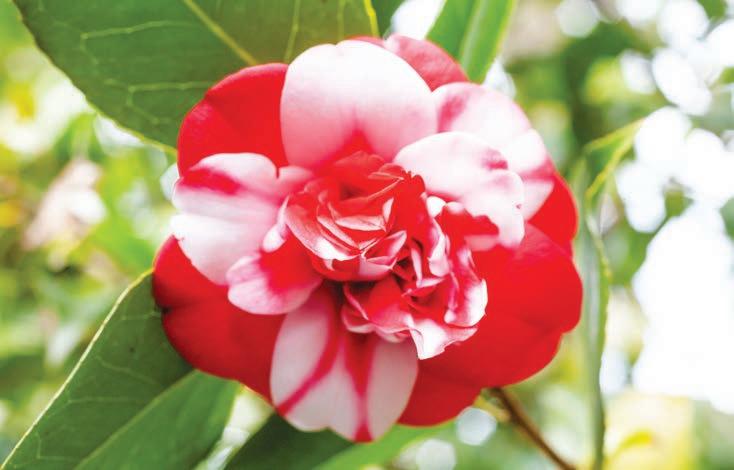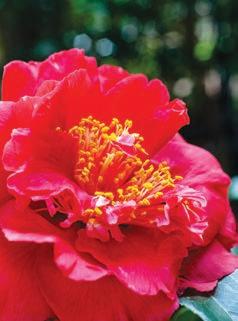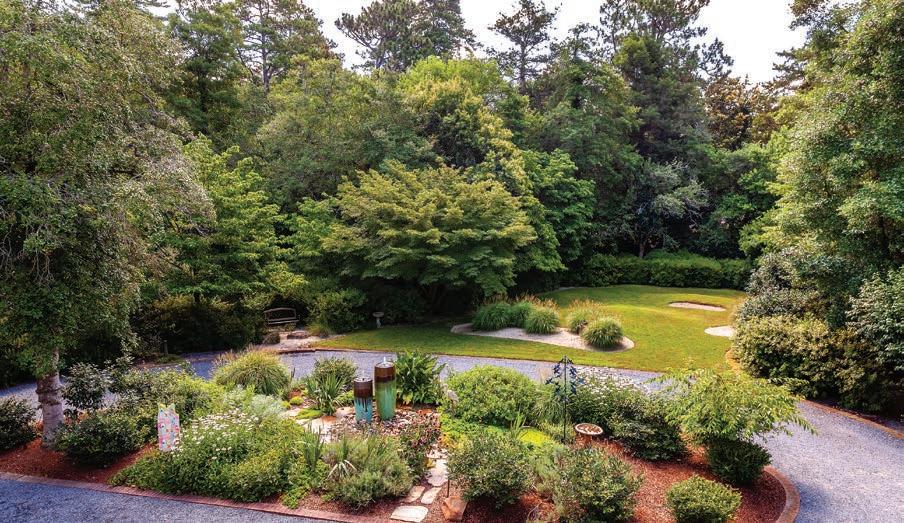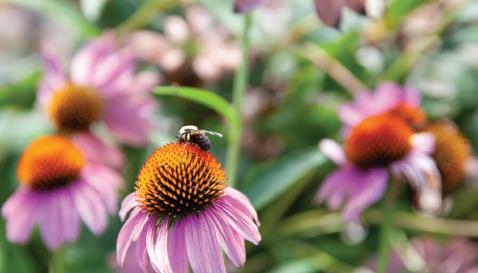
15 minute read
Cedarcrest in Bloom
Cedarcrest in

Advertisement
A free-spir it ed an d rom ant ic escape
By Cl audi a Watson • P hotogr a Phs By John gessner
Bloom




The light snow clinging to the winter-into-spring camellias prompted her early morning call last March. “Oh, you must come and see these camellias before the snow is gone,” said an enthusiastic June Buchele. “The blooms look stunning against the clear blue sky.”
T he first sig ns of spr ing are the sweetest in Bar r y and June Buchele’s garden. A war ming sun peak s through the treetops as we enjoy the spectacle of hundreds of vibrant large camellia blooms dusted with snow. It’s a st unning prelude to an intoxicating buf fet of things that star t small. Nearby, winter snowdrops and hellebores peek out f rom under layers of leaf mulch, and the br ight yellow stamens of crocus shout, “Spr ing is here!”
“Oh gosh, it’s my favor ite time of year,” says June, an accredited A mer ican Camellia Societ y (ACS) judge and an energetic N.C. Extension master gardener volunteer. “I can’t wait for the daf fodils to bloom,” pointing to the long g reen stalk s reaching for the sun.
T he Bucheles’ garden is a f re e - spir ite d a nd roma nt ic esc ap e w it h on ly a touch of d isc ipl ine for Mot her Nat ure. Just steps away f rom busy B eu la h Hi l l R oad, t he sound of t r a f fic f a l ls silent. T heir prop er t y in Old Tow n Pinehurst is obsc ure d b eh ind a t h ick ly pla nte d b order of big old- g row t h t re es a nd shr ubs. “No one k nows it’s even back here,” says Bar r y, who’s qu ick to share t he h istor y.
In 1916, James Wells Barber, an inter national shipping mag-

nate, purchased the 1.24-acre proper t y. He commissioned L eonard Tuf ts’ brother-in-law, architect Lyman Sise, to build the home for him and his wife, K ate. According to histor ical documents, they named the “t wo -stor y, weather-boarded, Tuscan- columned cottage, with t wo large stone chimneys” Cedarcrest.
Barber took a large por tion of the proper t y and built the “Lilliputian,” the countr y’s first nine-hole miniat ure golf course. Before they moved in, they commissioned Sise to constr uct a g rander Federal Revival mansion across the street. K now n as T histle Dhu, it was the location of the countr y’s first 18 -hole pitch-and-putt miniat ure golf course. Cedarcrest contr ibutes to Pinehurst’s desig nation as a National Histor ic L andmark.
Bar r y and his late wife, Sarah, purchased Cedarcrest in 1987. A n ob/g yn, he founded the Souther n Pines Women’s Health Center in 1981. It was a solo practice for nearly three years.
“I was work ing 80 to 10 0 hours a week and couldn’t leave Moore Count y for nearly three years since I was on 24-hour call,” he recalls. “W hen I had time of f, I was usually sleeping. Gardening was not on the top of my list, though I always had my tomato and pepper plants.”
A f ter Sarah ’s untimely death in 2012, Bar r y admits it was a rough time, recalling the empt y house, the untended garden, and the loneliness. He met June through an online dating site, and they mar r ied 16 months later.
“W hen we talked about getting mar r ied, June said to me, ‘If we get mar r ied, I’d like to br ing some color to the house and garden,’” he recalls. “I told her, ‘T here is no if,’ and I promised her she could. Her love of flowers adds so much to our home and life.”
Now semi-retired, Bar r y and his br ide of seven years share the love of the land and a passion for creating a beautif ul space, though he admits he didn’t k now what was outside his doors until he met and mar r ied June.
“June woke one mor ning and looked out the window,” he says. “She t ur ned to me, ask ing, ‘Bar r y, do you k now how many camellias you have out there?’”
He had no idea, so June pulled on her coat and boots and took the better par t of the mor ning to count. She ret ur ned to tell him, “T here are over 10 0 on the proper t y.” His astonished reply was, “Huh?”
T he Bucheles credit the previous ow ner for planting the garden’s bones with a collection of camellias (Camellia japonica and Camellia sasanqua), hollies and a zaleas g rowing under a canopy of longleaf pines and live oak s, g iving it subtle Souther n char m. T here is a comfor ting wildness to the place, with an abundance of deciduous trees and everg reen shr ubs stretching to the sunlight, providing a secure habitat for a herd of deer, rabbits, an occasional fox and t ur tle, and numerous birds. W hen flock s of chatter ing cedar wa x wings ar r ive in the winter to feed on the holly ber r ies, June hangs out the upstairs windows to watch and photog raph them.
With a deg ree in education f rom the Universit y of Nor th Carolina- Chapel Hill, she taught elementar y and inter mediate school science, English and Spanish. She also st udied botany with Clif ford Park s, a world-renow ned camellia exper t. T hat exper ience developed her k nowledge of botany, propagation, and the advantages of good soil fer tilit y. Still, she confesses she didn’t tr uly appreciate the beaut y of camellias until she moved to Pinehurst.
June was raised in Charlotte, where the dark red clay there was not favorable for camellias. Instead, her father and g randfather propagated and g rew box woods, her first love. Her mother enjoyed flowers and became a talented floral desig ner who won ikebana (the Japanese ar t of flower ar rang ing) competitions. “Gardening is in my Souther n her itage,” she says.
T he Bucheles claim 80 -90 var ieties of camellias among the 10 0 plus they count today, providing a lush backdrop dur ing the non-

blooming months for other shr ubs and continuously chang ing the landscape.
Despite the abundance of the broadleaved everg reens, last winter they built several raised beds for the exclusive pur pose of g rowing new camellias for exhibitions.
“We planted 44 new, rare or unusual camellia japonica var ieties,” June explains. “I keep them small and tidy — one plant, one bloom. You enter to win with a spectacular bloom.” She’s won awards t wo of the past three years.
T he new camellia beds receive special care and are sit uated in si x locations to deter mine the best one for g rowing each var iet y. Camellias thr ive in the reg ion’s acidic soil. Most prefer understor y shade or par t shade, but some have adapted to f ull sun. T hey g row best in soils high in organic matter, and the Bucheles fill the beds with a blend of Brook s eggshell compost and homemade compost.
Bar r y, now a seasoned gardener, is of ten up to his ank les in the compost, check ing and t ur ning it as it slowly develops under an ancient live oak. “T his is fluf f y, r ich and ready to go into the beds,” he says while scooping a fork f ul into the wheelbar row.
L ate winter, they usually pack up their van for the busy camellia judg ing schedule, attending shows up and dow n the East Coast. But this year, the for mat requires photos of entr ies sent by email and then judged on Zoom. “We’re not sure how this is going to work,” says a dubious June, who’s volunteered to be a judge at the first ACS competition this year, in Fayetteville, via Zoom.
In nor mal times, Bar r y volunteers as a show “r unner” — caref ully deliver ing the f rag ile single blooms perched in small cups to the head table for f ur ther judg ing. “Dropping or damag ing a bloom is not a good thing,” he says, noting an unblemished track record.
“We’ve lear ned so much,” adds June. “T he people I judge with are ver y passionate about g rowing and showing camellias and shar ing k nowledge. We’ve all become good f r iends, which makes it enjoyable for both of us. Plus, we get to see a lot of beautif ul places.”
T he division of labor in their garden is simple, explains Bar r y. “My main thought about gardening is, ‘W hat can I eat?’ June is more of, ‘W hat flowers can I cut and br ing into the house?’”
R a ise d in Tex a s, Bar r y’s f at her, a lso a do c tor, wou ld o c c a siona l ly t a ke Bar r y a nd h is brot her to t heir g r a ndf at her’s f ar m in

sout her n K a nsa s. “Garden ing a nd f ar m ing were in our blo o d,” he ex pla ins. “But Dad hate d f ar m ing a nd d idn’t wa nt to do it. He’d t a ke us t here a nd work our but t s of f. He wa nte d us to ga in a n ap pre c iat ion for a f ar mer’s hard work a nd to underst a nd t he imp ort a nc e of st ay ing in scho ol.
“So, now I’m in charge of the compost and var mint control,” he says, laughing as he readjusts his soil-smudged garden hat. Counter measures used to keep the rabbits and birds out of the vegetable garden include color f ul fake snakes hang ing f rom the tomato cages and a chicken-wire fence. Still, he admits, the voles get the best of them, “T hey ate the entire shade garden last year.”
In addition to the busy camellia season, spr ing br ings a multit ude of requisite heav y maintenance and week ly garden chores, which they’ve handed of f to Cooley and Co. L andscape. But they stay connected with the essence of Mother Nat ure.
June pluck s wilted foliage and prowls for weeds as she walk s. She stops abr uptly, reaching for an antique climbing rose. “It’s a Pier re de Ronsard,” the name lilting of f her tong ue. “T he color changes f rom a sof t pink to a deep rose,” she says, inhaling its heavenly f rag rance and passing it along for a snif f.
C ont inu ing dow n t he wa l k , June p oint s out are a s for a mbit ious cle a nup a nd pla nt ing proje c t s. “I move pla nt s a lot. If t hey are not doing wel l, I d ig ’em up a nd repla nt. T hat’s t he f un t h ing ab out garden ing — it’s a l l a n ex p er iment.” She laug hs a nd t ugs at a pr ick ly-iv y g re enbr ier (Smil a x rotun difoli a) br a nch t hat’s ent a ngl ing her b elove d p e on ies.
She discloses her plans for the a zaleas, which she despises. “T hey bloom once and are done. T hen they look legg y and sick ly, not at all like camellias with their beautif ul thick foliage.” So, last winter she took matters into her ow n hands and did extensive renovation pr uning. “T hey were this high,” she says, motioning to her shoulders. “Now, they’re a foot high. But they’ll g row out and be prett y again.”
A recent makeover of the f ront included replacing a forlor n wildflower garden with a chipping g reen. Car ved out of lush Xeon zoysia, it’s sur rounded by blossoming redbuds, pink and white dog woods, a zaleas, forsy thia, and g racef ul br idal wreath spirea. A dramatic Kousa dog wood (Cornus kousa) with its prof usion of large, white flower bracts and red ber r ies provides an attractive and long-lasting display throughout spr ing and summer.
Nearby, a large oval garden g races the house’s entrance. It’s an exuberant mi x of daf fodil bulbs, hardy camellias, English lavender, mi xed ranunculus, and clumps of Shasta daisies and gladiolas. Pollinator-f r iendly perennials include cheer f ul Black- eyed Susan (Rudbeckia hir ta L .), salvia, coneflowers, and a false wild yellow indigo (Baptisia tinctoria). T he spreading habit of several L antana ‘Chapel Hill ’ plants act as g roundcover to br ighten the area. Free-flower ing, ivor y- colored calla lilies (Zantedeschia ‘Intimate Ivor y’) create drama all season long.
Two tower ing potter y fountains anchor the bed while a longlegged, shar p -beaked stork poses quietly nearby. “Stork s are r umored to br ing babies, but Bar r y’s the one that does that,” says June of the counter feit bird. “He’s delivered over 11,0 0 0 babies, so I had to put one out there in his honor.”
But it’s the back of the proper t y that’s their pr ivate oasis. W hen



the old br ick patio began to heave f rom the pressure of nearby tree roots, they asked builder Ken Bonville to desig n and create an outdoor living space. “It’s f unctional with an outdoor k itchen, and it’s as welcoming and enter taining as a family room,” notes Bar r y.
“We made sure we had it screened so we’d enjoy it w ithout being eaten up by the bugs,” he says of the covered space w ith patio -to ceiling rolldow n screens. T he patio extends outside the covered str uct ure to include a coz y fire pit. Tw in big-screen T Vs, mounted back-to -back, a llow spor ts fans to enjoy the action inside or f rom the fire pit and pool area.
June enjoys dressing up the outdoor room with her ar tf ully arranged f reshly cut flowers. “To me, flowers make a house a home,” she says. “With this area and our pool, it fits how we live. We spend a lot of time together here. It’s rela xing and keeps us connected to the beaut y and serenit y of our garden.”
Native Bronze Di xie Sweet scupper nong g rapes w rap a long a trellis in a sunny por tion of the back yard. “T his var iet y is wonderf ul — big, sweet, and ver y juic y. Since June’s t ur ned over the g rapes to me, I handle the pr uning, and when we get good g rapes, I claim success,” Bar r y says.
Bordering the vineyard is June’s deer-resistant peony bed, which started with one selection from Tony Avent’s Plant Delights Nurser y, a favorite for plant hunters. That peony (Paeonia ‘Scarlet O’Hara’) led to yearly additions, and the bed now has over 30 peonies that bloom in time for Mother’s Day. Closer to the pool, there’s a collection of tropicallooking hardy ginger plants, including an exotic Hedychium coronarium with a fragrance similar to jasmine. Elephant ears (Colocasia), daylilies (Hemerocallis), and specimens of Amorphophallus titanium, known as the ‘Corpse flower,’ and Hippeastrum ‘Voodoo,’ add myster y.
Work ing side-by-side in the garden, the couple divide and conquer, with each tak ing on dif ferent task s. Ever y thing doesn’t always go as planned, but they take time to enjoy its beaut y and peacef ulness.
“A few years ago, I built the simple slate path that threads through the back of the proper t y. It’s bordered by dozens of a zaleas and camellias and it’s the most tranquil place when they’re blooming. I get lost in the flowers,” reflects Bar r y. “If it weren’t for June, there wouldn’t be a garden.”
T heir garden — a changeable, renewable paradise that stirs the senses and spir its, ig niting a love of life. PS
Cl au di a Wat son is a fre qu ent contr ib ut or t o PineSt r aw an d T he Pi lot an d fin d s th e jo y in e a ch d ay, of t en in a gard en.




